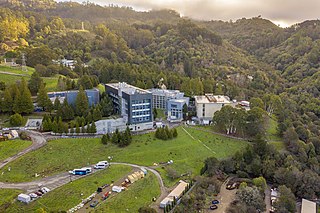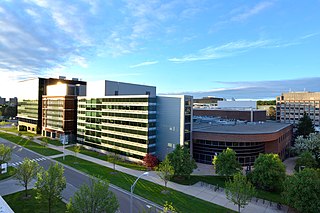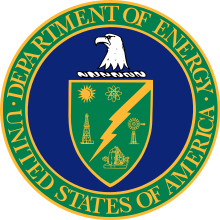
Los Alamos National Laboratory is one of the sixteen research and development laboratories of the United States Department of Energy (DOE), located a short distance northwest of Santa Fe, New Mexico, in the American southwest. Best known for its central role in helping develop the first atomic bomb, LANL is one of the world's largest and most advanced scientific institutions.

Oak Ridge National Laboratory (ORNL) is a federally funded research and development center in Oak Ridge, Tennessee, United States. Founded in 1943, the laboratory is now sponsored by the United States Department of Energy and administered by UT–Battelle, LLC.

Brookhaven National Laboratory (BNL) is a United States Department of Energy national laboratory located in Upton, Long Island, and was formally established in 1947 at the site of Camp Upton, a former U.S. Army base and Japanese internment camp. Its name stems from its location within the Town of Brookhaven, approximately 60 miles east of New York City. It is managed by Stony Brook University and Battelle Memorial Institute.

Lawrence Berkeley National Laboratory (LBNL) is a federally funded research and development center in the hills of Berkeley, California, United States. Established in 1931 by the University of California (UC), the laboratory is sponsored by the United States Department of Energy and administered by the UC system. Ernest Lawrence, who won the Nobel prize for inventing the cyclotron, founded the Lab and served as its Director until his death in 1958. Located in the Berkeley Hills, the lab overlooks the campus of the University of California, Berkeley.

The United States Department of Energy (DOE) is an executive department of the U.S. federal government that oversees U.S. national energy policy and energy production, as well as manages the research and development of nuclear power, the military's nuclear weapons program, nuclear reactor production for the United States Navy, energy-related research, and energy conservation.

Argonne National Laboratory is a federally funded research and development center in Lemont, Illinois, United States. Founded in 1946, the laboratory is owned by the United States Department of Energy and administered by UChicago Argonne LLC of the University of Chicago. The facility is the largest national laboratory in the Midwest.

The Spallation Neutron Source (SNS) is an accelerator-based neutron source facility in the U.S. that provides the most intense pulsed neutron beams in the world for scientific research and industrial development. Each year, this facility hosts hundreds of researchers from universities, national laboratories, and industry, who conduct basic and applied research and technology development using neutrons. SNS is part of Oak Ridge National Laboratory, which is managed by UT-Battelle for the United States Department of Energy (DOE). SNS is a DOE Office of Science user facility, and it is open to scientists and researchers from all over the world.

The Joint Genome Institute (JGI) is a scientific user facility for integrative genomic science at Lawrence Berkeley National Laboratory. The mission of the JGI is to advance genomics research in support of the United States Department of Energy's (DOE) missions of energy and the environment. It is one of three national scientific user facilities supported by the Office of Biological and Environmental Research (BER) within the Department of Energy's Office of Research. These BER facilities are part of a more extensive network of 28 national scientific user facilities that operate at the DOE national laboratories.
The Office of Energy Efficiency and Renewable Energy (EERE) is an office within the United States Department of Energy. Formed from other energy agencies after the 1973 energy crisis, EERE is led by the Assistant Secretary of Energy Efficiency and Renewable Energy, who is appointed by the president of the United States and confirmed by the U.S. Senate. Alejandro Moreno currently leads the office as the Acting Assistant Secretary.
High Performance Storage System (HPSS) is a flexible, scalable, policy-based, software-defined Hierarchical Storage Management product developed by the HPSS Collaboration. It provides scalable hierarchical storage management (HSM), archive, and file system services using cluster, LAN and SAN technologies to aggregate the capacity and performance of many computers, disks, disk systems, tape drives, and tape libraries.
The Office of Science is a component of the United States Department of Energy (DOE). The Office of Science is the lead federal agency supporting fundamental scientific research for energy and the Nation’s largest supporter of basic research in the physical sciences. The Office of Science portfolio has two principal thrusts: direct support of scientific research and direct support of the development, construction, and operation of unique, open-access scientific user facilities that are made available for use by external researchers.

A neutron research facility is most commonly a big laboratory operating a large-scale neutron source that provides thermal neutrons to a suite of research instruments. The neutron source usually is a research reactor or a spallation source. In some cases, a smaller facility will provide high energy neutrons using existing neutron generator technologies.

The Facility for Rare Isotope Beams (FRIB) is a scientific user facility for nuclear science, funded by the U.S. Department of Energy Office of Science (DOE-SC), Michigan State University (MSU), and the State of Michigan. Michigan State University contributed an additional $212 million in various ways, including the land. MSU established and operates FRIB as a user facility for the Office of Nuclear Physics in the U.S. Department of Energy Office of Science. At FRIB, scientists research the properties of rare isotopes to advance knowledge in the areas of nuclear physics, nuclear astrophysics, fundamental interactions of nuclei, and real-world applications of rare isotopes. Construction of the FRIB conventional facilities began in spring 2014 and was completed in 2017. Technical construction started in the fall of 2014 and was completed in January 2022. The total project cost was $730M with project completion in June 2022.

The Los Alamos Neutron Science Center (LANSCE), formerly known as the Los Alamos Meson Physics Facility (LAMPF), is one of the world's most powerful linear accelerators. It is located in Los Alamos National Laboratory in New Mexico in Technical Area 53. It was the most powerful linear accelerator in the world when it was opened in June 1972. The technology used in the accelerator was developed under the direction of nuclear physicist Louis Rosen. The facility is capable of accelerating protons up to 800 MeV. Multiple beamlines allow for a variety of experiments to be run at once, and the facility is used for many types of research in materials testing and neutron science. It is also used for medical radioisotope production.
Alvin William Trivelpiece was an American physicist whose varied career included positions as director of the Office of Energy Research of the U.S. Department of Energy (DOE), executive officer of the American Association for the Advancement of Science (AAAS), and director of Oak Ridge National Laboratory (ORNL). He was also a professor of physics and a corporate executive. Trivelpiece's research focused on plasma physics, controlled thermonuclear research, and particle accelerators. He received several patents for accelerators and microwave devices. He died in Rancho Santa Margarita, California in August 2022 at the age of 91.

John M. "Jack" Carpenter was an American nuclear engineer known as the originator of the technique for utilizing accelerator-induced intense pulses of neutrons for research and developing the first spallation slow neutron source based on a proton synchrotron, the Intense Pulsed Neutron Source (IPNS). He died on 10 March 2020.

JoAnne L. Hewett is a theoretical particle physicist on the faculty of the SLAC National Accelerator Laboratory at Stanford University, where she is a professor in the Department of Particle Physics and Astrophysics. Since 2017 she has been the associate lab director of the Fundamental Physics Directorate and the chief research officer at SLAC. Her research interests include physics beyond the Standard Model, dark matter, and hidden dimensions. She is a fellow of the American Physical Society and a fellow of the American Association for the Advancement of Science (AAAS).

Stephen K. Streiffer is an American materials scientist who began serving as the director of Oak Ridge National Laboratory in 2023. Prior to this position, he served as interim director at SLAC National Accelerator Laboratory. Streiffer joined Stanford University in 2022 as vice present for SLAC National Accelerator Laboratory after 24 years at Argonne National Laboratory.
Science tourism is a travel topic grouping scientific attractions. It covers interests in visiting and exploring scientific landmarks, including museums, laboratories, observatories and universities. It also includes visits to see events of scientific interest, such as solar eclipses.
The National User Facilities are a set of large-scale scientific facilities maintained by the U.S. Department of Energy, Office of Science, whose roles are to provide the scientific community with world-leading scientific instruments to enable research. These facilities are generally free to use, and are open to scientists from all over the world, usually through the submission and evaluation of research proposals.

















